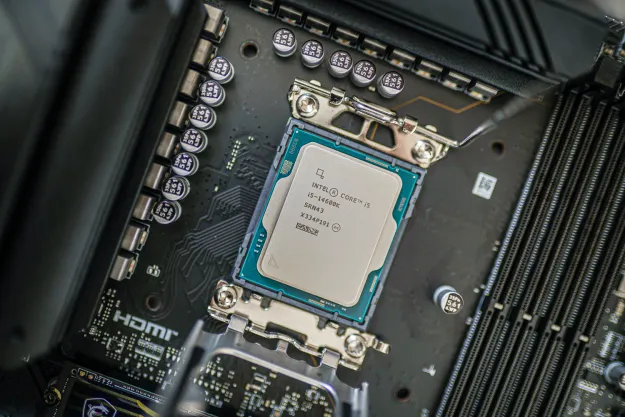This story is part of our continuing coverage of CES 2020, including tech and gadgets from the showroom floor.
CES announcements are nearing their end, but Intel has one more reveal, and it’s big. Intel gave Digital Trends and a small group of media outlets a world-first look at the desktop version of the company’s upcoming desktop graphics card, the Intel DG1.
The desktop Intel DG1 was there in the flesh, running in a desktop system. The card was powering the popular free-to-play shooter Warframe, which isn’t known for slaying graphics cards. Even so, the game plodded along at a tepid 30 frames per second at 1080p resolution. It wasn’t too impressive. The framerate was visibly choppy and screen tearing was a noticeable issue.

Intel insists you shouldn’t write off the project based on that. That’s because the Intel DG1 I tested isn’t anywhere close to the final card. It’s what Intel calls a “software development vehicle,” meant to prepare its partners in the developer community for the eventual wide-scale release of the DG1 and other Intel Xe graphics solutions. In other words, the final graphics card you might end up buying won’t look like this early sample.
Intel says this is an important step towards a successful consumer launch. Xe is, after all, a brand new platform for developers to adopt, and Intel is determined to ease developers and software vendors into optimizing for it.

There’s a lot of truth to what Intel says. There’s no release date for Intel’s Xe discrete graphics card and, unlike Nvidia and AMD, Intel is building this architecture from the ground up. Intel simply lacks the cache of its competition in this field. Sending cards to developers as an early proof of concept is always part of designing a new architecture, but it’s particularly important for Intel’s entry into discrete graphics.
Intel has a number of AI-powered performance boosts that require optimization and close partnership with developers. These new capabilities are selling points for Intel’s marketing of Xe, and Intel says it’s important it all works on day one.
It looks finished, even if it isn’t
The many caveats surrounding this early sneak peak at Intel DG1 might make you think the card itself is just a PCB with a fan held on by a paperclip. Nope! The DG1 is an attractive piece of hardware that doesn’t look far off most retail graphics cards.
It features a swanky aluminum shroud, a stylish Xe logo on the back, and programmable RGB lighting. The design uses a single blower fan for cooling, and the shroud wraps around the fan in a way that suggests airflow. It looks like a piece of high-end graphics kit, yet it’s not as intimidating as the black-and-gray monoliths shipped by AMD and Nvidia.
The card I saw had three DisplayPort connections and an HDMI port across the rear. I doubt that’s indicative of what the final Intel Xe cards will ship with. Developers are more willing to use dongles than consumers, who will certainly demand HDMI, at the least.

Intel declined on any information about pricing, performance, or release date. The company also wouldn’t say where this particular card might land in the final line-up, or if it will even ship to retail.
From the look of it, and its performance, I’d guess the Intel DG1 represents an entry-level graphics product. The most powerful Intel Xe cards are almost certain to be larger, beefier pieces of hardware, similar to what AMD and Nvidia produce.
The secret is out
As a whole, the company has been secretive about the exact details of its new Xe graphics architecture. At its CES 2020 press conference earlier this week, Intel gave the world a very brief look at the mobile version of the DG1, with almost no details about what it was (outside of its ability to play Destiny 2).
What we do know, however, is that the Xe architecture will be shared across the entire lineup of graphics cards, ranging from high performance computing to low performance machines, with micro-architectures optimized for each sector.
Intel says it’s already sampling the DG1 to developers, and will continue to do so throughout the rest of 2020. We’re sure to hear more about it, and other Intel Xe hardware, this year.
Follow our live blog for more CES news and announcements.
Editors' Recommendations
- 4 CPUs you should buy instead of the Intel Core i9-13900K
- Intel Battlemage graphics cards: release date speculation, price, specs, and more
- It just became the perfect time to buy a last-gen Intel CPU
- Intel may fire the first shots in the next-gen GPU war
- Gamers are reportedly returning Intel Core i9 CPUs in droves


